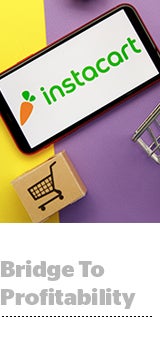Here’s today’s AdExchanger.com news round-up… Want it by email? Sign up here.
Is The Cart Half Full Or Half Empty?
Instacart’s grocery delivery business has slowed, or at best is showing zero sales growth from this time last year. That’s largely because quarantines forced people to order online, and many have returned to in-store shopping. Frankly, it’s impressive grocery delivery remained steady. But Instacart’s year-over-year performance metrics will be distorted for years to come, which hurts during the pre-IPO phase. Instacart hopes ad revenue will be a bridge to profitability while grocery delivery goes through a period of relative stasis, since a decade’s worth of adoption was compressed into Q2 2020. Instacart is all-in on retail media, with the addition of two former Facebookers who joined this year: CEO Fidji Simo and President Carolyn Everson. Not to mention CRO Seth Dallaire, who previously ran Amazon’s advertising business. Instacart’s ad platform earned $300 million in 2020, and the goal is to grow that to $1 billion by the end of next year, The Wall Street Journal reports. “We have such a big opportunity. The challenge is executing fast enough to capture it,” Simo said.
Apple MyOS
There’s a bottleneck in the app ecosystem. And the problem is the Apple App Store, according to Stratechery. The app economy is fueled by creators – people who earn attention and monetize on top of apps like Facebook, Instagram, Snapchat and TikTok, as well as gaming or community hubs like Fortnite and Roblox. Because Apple takes a 30% cut on all iOS earnings, the number of supporters a service needs to reach to become profitable at scale is astronomical. Roblox, a smash hit video game company with a $50 billion market cap, has tens of millions of daily users and pays its developer-creators “pennies on the dollar.” But it still isn’t profitable. Twitter is also working on a Super Follows feature to charge subscription rates for exclusive content; but even with its network, the revenue potential is slim for both Twitter and the creators. “Apple is absolutely right that the App Store created economic opportunity; it is also taking it away from an expanding universe of creators and developers who have no reason to interact with iOS APIs.”
An Honest Buck
Hulu raised the price of its ad-supported and ad-free packages by $1 per month to $6.99 and $12.99, respectively. ESPN Plus and Disney Plus – Disney’s other stand-alone streaming services – also increased monthly charges by a dollar this year. (They’re now $6.99 and $7.99, respectively.) Disney kept streaming rates low to start (even free for the first year via partners such as Verizon and AT&T), with the plan to raise prices once subscribers had stuck around for a rebilling cycle. But Hulu is a special case, because of its ad-supported and programmatic approach. The Disney bundle app, which includes all three streaming services and live TV, now costs $1 more than the ad-free Hulu tier. Shuffling Hulu subscribers to the Disney bundle is good: one super-popular app can outperform two fairly popular titles. But Disney needs the Hulu ad-supported tier to remain strong. If it syphoned off too many subscribers, it would undercut the auction.
But Wait, There’s More!
Facebook advertisers struggle to track sales after Apple privacy changes. [Ad Age]
The strange tale of the Freedom Phone, a smartphone for conservatives. [NYT]
Smaato’s H1 2021 Trend Report highlights publisher revenue rally. [release]
Fox Sports starts selling ads for the Super Bowl in 2023 – at $6M per 30-second spot. [Adweek]
Microsoft rolled out its Microsoft Start personalized news service. [TechCrunch]
You’re Hired
Ford hires Doug Field to lead its emerging tech efforts. [CNBC]
LinkedInclusion appoints Angela Harris as CMO. [Campaign]
Anheuser-Busch InBev taps Benoit Garbe as CMO in the US. [Ad Age]













